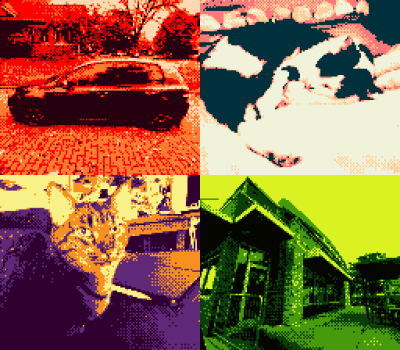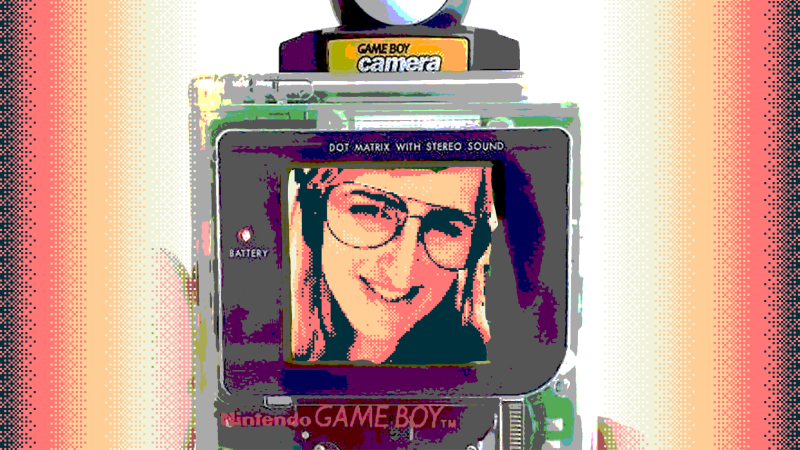Never underestimate the power of nostalgia. In an age when there are more megapixels stuffed in the sensor of a smartphone camera than the average computer display can even represent, why would jagged images from a 20-year-old grayscale camera with pixels numbering in the thousands still grab attention? Maybe what’s old is new again, and the coolness factor of novelty is something that can’t be quantified.
The surprise I had last Monday when I saw my Twitter notifications is maybe only second to the feeling I had when I was invited to become a Hackaday contributor. I’d made a very simple web app which mimics a Game Boy Camera using the camera from your phone or desktop, and it got picked up by people so much that I’m amazed my web host is still holding. Let’s look at why something seemingly so simple gained so much traction.
What Is The Game Boy Camera?
The Game Boy Camera was a 1998 Nintendo peripheral for their popular Game Boy handheld, first released in 1989. Looking like a slightly odd cartridge with a bulbous addition at the top, it was designed to turn a relatively inexpensive video game system into a digital camera at a time when such devices could come at a significant premium. Internally however, the project wasn’t as popular with Nintendo executives during development as it is today. To make it more appealing, the team led by Hirokazu Tanaka also included minigames and different camera functions, adding value to a project that would be otherwise seen as uncharacteristic for the company.

The CMOS sensor embedded into the cartridge was limited to a maximum resolution of 128×128 — though it was cropped to 128×112 by the software that ran it. This was a combination of a limitation on the Game Boy’s screen resolution, and the fact that a lower resolution sensor would be inexpensive enough to keep it in toy territory for Nintendo instead of competing with consumer-grade cameras. But the low fidelity of such a limited technology was arguably its biggest selling point: Through the use of ordered dithering, otherwise ordinary pictures can easily be turned into beautiful 2-bit pixel art.
If you still have the original Game Boy Camera lying around, it’s popular in the hacker world too: The protocol used by the memory banks in the cartridge have been reverse-engineered in order to pull the original pictures into a computer, and with some 3D printing you can attach professional-grade camera lenses to the sensor.
But Why Is It So Popular?

This is a tough question to answer given that taste and preferences are highly subjective, but I can give my own personal experience with it in order to attempt an educated guess. Putting aside vaporwave aesthetics and 90s retro nostalgia, effectively what you have is the equivalent of a modern day camera filter.
When you scale a comparatively huge picture down to the original Game Boy Camera’s resolution and apply a Bayer dithering algorithm to reduce it to 4 colors, what you get on the other end is a highly stylized view of your subject. This contrast with the hyper-realistic view we’re so used to phone cameras having, with their increasing number of megapixels, can have a pleasing artistic effect.

It’s like taking a few steps back, or looking at something without your glasses. Once you take away all the little details and what you’re left with is only an approximate representation, the imperfections of a picture vanish away and our brains are left to fill in the missing information.
The Game Boy Camera has been used repeatedly to that effect by many artists and photographers to this day, but perhaps most notably by [Neil Young], who used a picture straight from it as the cover for his album Silver & Gold in 2000. This sort of artistic quality in a more modern application such as selfies wasn’t something I discovered by myself, in fact someone else had already done this before me, and it’s why I made my app today.
Six years ago in 2014, I had come across a Flash-based app almost exactly like mine created by [Christine Love] called Interstellar Selfie Station (ISS). It mimicked the look and feel of the Game Boy Camera, and it presented itself as an irreverent new tool, coated with an inviting queer attitude. The author herself said in an interview to the Daily Dot:
What I like about the Interstellar Selfie Station is that it gives you just a little bit more control over how you look, and I’ve noticed this blowing up on my Twitter feed: Suddenly that makes people who are otherwise terrified to post pictures of themselves seem a lot more confident.
So Why Did I Make This?
Also six years ago, I was starting my gender transition and having really bad dysphoria and self-esteem issues. Interstellar Selfie Station, at the time, offered a refreshing look at my own self that I felt comfortable with and in sharing with others, enabling me to take back control of how I viewed myself. I was one of the people [Love] was talking about, the perfect target audience for her app. Some time after the final mobile version of ISS launched, it was suddenly pulled from app stores without an explanation and never mentioned again. It’s unclear why, but it definitely left a gap in the niche it had found itself. Ever since then, I’ve wanted to recreate it so I could capture that feeling again and share it with others.
Fast-forward to today, it’s possible to make camera apps like these without plugins or external downloads, thanks to recent additions to HTML5 and JavaScript. In a couple of days, I had a working web app that mirrored most of the functionality of the original one that had amazed me. Behind the scenes, which you can check on GitHub, the app is nothing but a couple of canvas elements rendering and filtering a live feed from a user camera through a bit of hand-assembled JS. Perhaps as proof to the saying that less is more, it really goes to show that for something to have such a big impact it does not need to be complicated.
At first I’d only made it to fulfill my own nostalgic need for the Interstellar Selfie Station, and I had no idea it would’ve resonated with so many people the same way it did to me. And what I like the most is that this time around people aren’t only sharing selfies, but also pictures of pets, nature and landscapes, all seen through artistic, retro lo-fi spectacles. My Twitter notifications for the past week have been flooded with thankful people and their lovely pictures, including heartwarming messages about how the app helped their own self-image issues. It serves to me as a reminder of how tech can be used for good, and why we should keep striving to do just that.
















💜💜💜💜 congrats
I didn’t grow up the gameboy, but your camera app is super fun to play around with. I love that dithering look. I also can’t believe how clear 128×112 can be
I had the same feeling about the quality of the low-res images. Especially since she included the exposure tweaks that do a great job on bringing out definition of the big parts of the image.
The old Mac system 7 (?) included 1-bit portraits of the devs at 32×32 pixels. They were amazingly good.
“Some time after the final mobile version of ISS launched, it was suddenly pulled from app stores without an explanation and never mentioned again. It’s unclear why, but it definitely left a gap in the niche it had found itself.”
Because Apple decided Flash Must Die and they removed all apps that had used Flash anywhere in their chain of development from their app store.
Distorted reality.. seems to be the order of the day …..
Maybe Steve Jobs was the protagonist of the current state of affairs with his “Reality distortion field” ?
There was also a thermal printer released by Nintendo to go with the camera: https://en.m.wikipedia.org/wiki/Game_Boy_Printer
Your app is like a little madeleine at breakfast. I delightfully open it, and it put back a smile on mt face.
Thanks for your work, the nice write up, and the code repository !
trans solidarity <3
There is a nice little app called Retroboy on the Play store and F-Droid that simulates the Gameboy Camera and a few other retro resolutions and color palettes.
thank you for making this! ive only ever been able to experience the iss when it was a flash game and have missed it dearly ever since. glad i found this today!